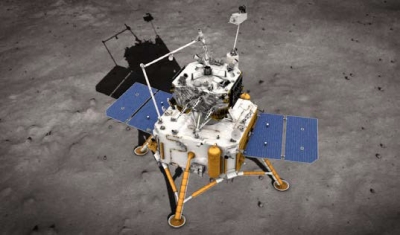
Chinese space probe Chang’e- 5, carrying rocks and soil from the Moon, returned to Earth safely on December 17. The capsule carrying the samples landed in northern China’s Inner Mongolia region. This is the first lunar sample return since 1976, when the former Soviet Union’s Luna 24 returned with lunar material. What’s the current mission all about? What happened to the Moon rocks that were recovered by the U.S. and Russia?
What is Chang’e-5 mission about?
Chang’e-5 is a robotic mission of the Chinese Lunar Exploration Program, launched on November 23, 2020. The Chang’e 5 probe included a lander, an ascender, orbiter and a returner. After it entered the designated circular lunar orbit, the lander-ascender pair separated from the orbiter-returner group and descended and successfully touched down near Mons Rumker, a volcanic mountain in the Moon’s huge Oceanus Procellarum (“Ocean of Storms”) region on December 1, 2020. The mission spent only two days on the Moon’s surface, gathering samples by digging and scooping. The 2kg samples were loaded onto an ascent vehicle that subsequently docked with an Earth return module. The service module of the mission’s orbiter then released the return capsule, which eventually landed on Earth with the samples on December 17.
What is the significance of the landing site?
- The landing site is a volcanic plain called Mons Rumker in the Oceanus Procellarum region on the Moon’s near side. The places explored by Apollo and Luna were all more than 3 billion years old, whereas Mons Rumker is estimated to be around 1.2 billion years old.
- A young surface is smooth and almost unblemished, while an old surface is heavily cratered With Moon rocks collected by Neil Armstrong and other astronauts, scientists could measure radioactive elements in the rocks and precisely calculate when a volcanic eruption had occurred, and thus the age of the parts of the Moon where the Apollo explorers set foot But none of the previous missions landed on a younger part of the Moon, leaving a large gap of uncertainty.
- Scientists also want to understand the differences in composition of the varying parts of the Moon, and the samples might explain how part of the Moon was still molten some 3 billion years after it formed.
How will the samples help scientists understand the Moon?
The new specimens could provide fresh insights into the geology and early history of Earth’s natural satellite. Scientists hope the samples will help them learn about the Moon’s origins, formation and volcanic activity on its surface. China will make some of the samples available to scientists in other countries.
Where are the Moon rocks previously collected by the U.S. and Russia now?
In the 1970s, three successful Soviet Luna missions brought back a total of 301 grams of Moon samples. NASA’s Apollo astronauts lugged back 842 pounds of Moon rock and soil Scientists are still studying the Apollo and Luna samples.
- The Moon samples collected by Apollo astronauts are stored at the Lunar Sample Laboratory Facility at NASA’s Johnson Space Center in Houston, Texas, in nitrogen filled steel cabinets. Some of those collected by Luna missions had been auctioned.
- In 2000, the U.S. decided to give away Moon rocks to 32 Apollo astronauts, on the condition that they should not be sold.
- Moon rocks collected by Apollo 11 and Apollo 17 astronauts were given away to 135 countries around the world and the 50 U.S. states as a token of goodwill.
What are China’s other moon missions?
In this century so far, only China has successfully put robotic spacecraft on the surface of the Moon: Chang’e-3 in December 2013, and Chang’e-4 in January 2019 became the first spacecraft to land on the far side of the Moon Chang’e-4 is still roving and studying lunar geology. Chang’e-1 and Chang’e-2 were lunar orbiters, launched in 2007 art 2010 respectively. All the missions have been named after the Chinese Moon goddess, Chang’e.
What are China’s upcoming Moon missions?
China plans to launch a spacecraft called Change 6 to return samples from the Moon’s South pole. The more advanced Chang’e 7 and Chang’e-8 spacecraft are also slated to land near tire south pole to carry out analysis of the region and test new technologies, including detecting and extracting materials such as water and hydrogen that could be useful to future human explorers, and testing 3D printing on the lunar surface China hopes to launch an international Lunar research station and ultimately a human colony on the Moon by the 2030.
Picture Credit : Google




